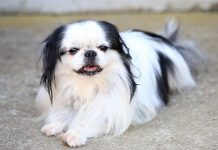History and Origins of the Patterdale Terrier Breed

The Patterdale Terrier is a robust and energetic breed that originated in the Lake District of England. This terrier is known for its working abilities, tenacity, and versatility. Here’s a look at the history and origins of the Patterdale Terrier:
- Origins: The Patterdale Terrier’s history dates back to the 18th century in the Lake District of Cumbria, England. It was developed from various terrier breeds, including the Old English Terrier, Fell Terrier, and Border Terrier, among others.
- Purpose: Patterdale Terriers were bred primarily for hunting and controlling vermin, such as rats, foxes, and rabbits. They were valued for their ability to work in rugged terrain and harsh conditions.
- Terrier Tradition: The breed was particularly popular among farmers and gamekeepers for its ability to eradicate pests and protect livestock. Patterdale Terriers were also used in hunting foxes and other small game.
- Selection and Development: Over time, the Patterdale Terrier was selectively bred for its hunting prowess, compact size, and strong work ethic. The breed’s traits were honed to excel in the demanding tasks required of a working terrier.
- Recognition: The Patterdale Terrier is not officially recognized by major kennel clubs like the AKC (American Kennel Club) or KC (The Kennel Club UK) as a distinct breed. Instead, it is often classified under the broader umbrella of “Fell Terriers” or “Working Terriers.”
Physical Characteristics and Appearance of Patterdale Terriers
The Patterdale Terrier is a compact and muscular dog known for its athletic build, keen expression, and rugged appearance. Here are the key physical characteristics and appearance traits of Patterdale Terriers:
- Size: Patterdale Terriers are small to medium-sized dogs, typically weighing between 11 to 13 pounds (5 to 6 kg) for males and slightly less for females. They stand around 12 to 15 inches (30 to 38 cm) tall at the shoulder.
- Body: The breed has a sturdy and well-proportioned body, with a level back, deep chest, and strong legs. Despite their small size, Patterdale Terriers are agile and powerful.
- Head: Patterdale Terriers have a distinctive head with a broad skull, strong muzzle, and well-developed jaw. They have dark, expressive eyes that convey intelligence and alertness.
- Ears: The ears are V-shaped and fold forward, giving the breed a keen and attentive expression. Some Patterdale Terriers may have semi-erect ears or fully erect ears.
- Tail: The tail is traditionally docked in countries where this practice is allowed. In countries where docking is prohibited, the tail is left natural and carried erect or slightly curved.
- Coat: Patterdale Terriers have a dense, wiry coat that provides protection from the elements. The coat is weather-resistant and can be either smooth or rough. Common coat colors include black, chocolate, red, liver, and tan.
- Expression: Patterdale Terriers have a bold and confident expression, reflecting their fearless nature and working heritage.
- Gait: The breed moves with a purposeful and efficient gait, showcasing their agility and stamina.
- Overall Appearance: Patterdale Terriers possess a no-nonsense appearance, devoid of exaggeration. They are bred for function and versatility rather than ornamental qualities.
- Working Ability: Patterdale Terriers are highly skilled hunters and excel in activities like ratting, earthdog trials, and agility. They are known for their determination and drive when pursuing prey.
Patterdale Terriers are valued for their hardworking nature, intelligence, and loyalty. While they excel in outdoor activities and working roles, they also make devoted companions for active families who appreciate their rugged charm and spirited personality. Proper training, socialization, and regular exercise are essential for bringing out the best in this versatile and capable terrier breed.
Patterdale Terrier Temperament and Personality Traits
The Patterdale Terrier is known for its lively temperament, strong work ethic, and spirited personality. This breed is energetic, intelligent, and determined, making them excellent working dogs and companions. Here are the key temperament and personality traits of Patterdale Terriers:
- Fearless and Tenacious: Patterdale Terriers are fearless dogs with a strong hunting instinct. They are known for their courage and determination when faced with challenging tasks or prey.
- Energetic and Active: This breed is highly energetic and requires regular exercise and mental stimulation to thrive. Patterdale Terriers enjoy activities like running, hiking, and engaging in interactive play.
- Intelligent and Quick-Witted: Patterdale Terriers are intelligent dogs that excel in problem-solving tasks. They are quick learners and respond well to positive reinforcement training methods.
- Alert and Watchful: Patterdale Terriers are naturally alert and vigilant. They make excellent watchdogs and will alert their owners to approaching strangers or unusual activities.
- Loyal and Affectionate: Despite their strong-willed nature, Patterdale Terriers are loyal and devoted to their families. They form strong bonds with their owners and enjoy being active participants in family life.
- Independent Thinkers: Patterdale Terriers have an independent streak and may exhibit a degree of stubbornness. Consistent training and positive reinforcement are essential to channel their intelligence and enthusiasm.
- Playful and Spirited: Despite their work-oriented background, Patterdale Terriers have a playful and mischievous side. They enjoy interactive games and thrive on mental and physical challenges.
- Good with Families: Patterdale Terriers can be excellent family pets for active households. They are typically good with children but may have a strong prey drive, requiring supervision around smaller pets.
- Socialization Needs: Early and ongoing socialization is crucial for Patterdale Terriers to develop good manners and confidence. Expose them to various people, animals, and environments to prevent shyness or fearfulness.
- High Prey Drive: Due to their strong hunting instincts, Patterdale Terriers may chase small animals. Proper training and supervision are necessary to manage their prey drive.
- Need for Mental Stimulation: Patterdale Terriers thrive on mental stimulation and may become bored or destructive without sufficient activity. Provide puzzle toys, training sessions, and interactive games to keep them engaged.
- Determination: Patterdale Terriers are determined dogs that will persevere in tasks they find rewarding or challenging. This trait can be harnessed through structured training and positive reinforcement.
Training and Socialization Needs for Patterdale Terriers
Proper training and socialization are essential for managing the spirited nature of Patterdale Terriers and ensuring they become well-rounded companions. Here are some training and socialization tips for Patterdale Terriers:
- Start Early: Begin training and socialization as soon as you bring your Patterdale Terrier puppy home. Early exposure to various people, animals, and environments helps build confidence and good behavior.
- Use Positive Reinforcement: Patterdale Terriers respond best to positive reinforcement techniques such as treats, praise, and play. Reward desired behaviors and avoid harsh corrections or punishment.
- Obedience Training: Teach basic obedience commands such as sit, stay, come, and heel using consistent and patient methods. Keep training sessions short, fun, and engaging to hold their interest.
- Channel Energy Appropriately: Provide ample opportunities for physical exercise and mental stimulation. Activities like daily walks, interactive games, and agility training help burn off excess energy.
- Manage Prey Drive: Due to their hunting instincts, Patterdale Terriers may chase small animals. Use leash training and supervised introductions to manage their prey drive around other pets.
- Socialize Regularly: Expose your Patterdale Terrier to different people, dogs, and environments to prevent fearfulness or aggression. Visit parks, attend training classes, and invite guests to your home.
- Set Clear Boundaries: Establish consistent rules and boundaries for your Patterdale Terrier. Be firm but fair in enforcing rules to prevent undesirable behaviors.
- Provide Mental Challenges: Keep your Patterdale Terrier mentally stimulated with interactive toys, puzzle games, and training sessions. This helps prevent boredom and destructive behaviors.
- Be Patient and Consistent: Patterdale Terriers are intelligent but may be stubborn at times. Stay patient, consistent, and positive in your training approach to achieve the best results.
- Monitor Interactions: Supervise interactions with children and other pets to ensure safe and positive experiences. Teach children how to interact respectfully with the dog.
- Stay Engaged: Patterdale Terriers thrive on companionship and involvement in family activities. Include your dog in daily routines and provide plenty of attention and affection.
With proper training, socialization, and consistent leadership, Patterdale Terriers can become well-mannered, affectionate, and loyal companions. Their spirited personality and working drive make them excellent partners for active individuals or families who appreciate their lively nature and devotion.
Health Considerations and Common Issues in Patterdale Terriers
Patterdale Terriers are generally healthy and robust dogs with a long lifespan, but like all breeds, they may be prone to certain health conditions. Understanding these potential issues and providing appropriate care can help ensure the well-being of your Patterdale Terrier. Here are some common health considerations and issues in Patterdale Terriers:
- Patellar Luxation: This is a condition where the kneecap (patella) dislocates from its normal position, causing lameness or difficulty walking. Patellar luxation can range from mild to severe and may require surgical correction.
- Hip Dysplasia: Patterdale Terriers may be susceptible to hip dysplasia, a genetic condition where the hip joint doesn’t develop properly. This can lead to arthritis and mobility issues over time.
- Legg-Calve-Perthes Disease: This is a condition where the blood supply to the femoral head (top of the thigh bone) is disrupted, leading to degeneration of the bone. It can cause pain and lameness in affected dogs.
- Progressive Retinal Atrophy (PRA): PRA is an inherited eye disorder that leads to gradual vision loss and can eventually cause blindness. Regular eye exams by a veterinary ophthalmologist are recommended for early detection.
- Cataracts: Patterdale Terriers may develop cataracts, which cloud the lens of the eye and impair vision. Surgical intervention may be necessary to restore vision in severe cases.
- Hypothyroidism: Some Patterdale Terriers may experience hypothyroidism, a condition where the thyroid gland doesn’t produce enough hormones. Symptoms include weight gain, lethargy, and coat changes.
- Allergies: Like many other breeds, Patterdale Terriers can develop allergies to environmental triggers (pollen, dust mites) or certain foods. Symptoms may include itching, skin irritation, and gastrointestinal issues.
- Dental Issues: Small terrier breeds like Patterdales are prone to dental problems such as periodontal disease and tooth decay. Regular dental care, including tooth brushing and professional cleanings, is important for oral health.
- Ear Infections: Patterdale Terriers with floppy ears may be prone to ear infections, especially if their ears are not kept clean and dry. Regular ear cleaning and inspection can help prevent infections.
- Obesity: Due to their hearty appetites and high energy levels, Patterdale Terriers may be prone to obesity if overfed or under-exercised. Maintain a balanced diet and provide regular exercise to prevent weight gain.
- Heat Sensitivity: Patterdale Terriers have a dense coat and may be sensitive to heat. Avoid exercising them in hot weather and provide shade and plenty of water during outdoor activities.
- Injuries: Due to their adventurous nature and fearlessness, Patterdale Terriers may be prone to injuries such as cuts, scrapes, or fractures. Supervise outdoor activities and provide a safe environment.
Living with a Patterdale Terrier: Suitable Environments and Lifestyle Considerations

Patterdale Terriers are active, spirited dogs that thrive in environments where they receive ample exercise, mental stimulation, and companionship. Here are some lifestyle considerations for living with a Patterdale Terrier:
- Active Lifestyle: Patterdale Terriers require regular exercise to maintain their physical and mental well-being. Daily walks, playtime, and interactive games are essential to keep them happy and healthy.
- Secure Enclosures: Due to their hunting instincts and high prey drive, it’s important to have a securely fenced yard or outdoor space for your Patterdale Terrier to safely explore and play.
- Training and Mental Stimulation: Engage your Patterdale Terrier in obedience training, agility courses, or interactive puzzles to keep their minds sharp and prevent boredom.
- Socialization: Early and ongoing socialization is crucial for Patterdale Terriers to develop good manners and interact positively with other dogs and people. Expose them to various environments and experiences from a young age.
- Supervision with Small Pets: Patterdale Terriers have a strong prey drive and may not be suitable for households with small pets like cats or rabbits. Supervise interactions and provide separate spaces if needed.
- Grooming Needs: Patterdale Terriers have a short, dense coat that requires minimal grooming. Regular brushing and occasional baths are sufficient to keep their coat clean and healthy.
- Regular Veterinary Care: Schedule routine veterinary check-ups, vaccinations, and preventive care to monitor your Patterdale Terrier’s health and address any potential issues promptly.
- Structured Routine: Establish a consistent daily routine that includes feeding times, exercise sessions, training, and relaxation. Patterdale Terriers thrive on structure and predictability.
- Family Interaction: Patterdale Terriers are loyal and affectionate companions that enjoy being part of the family. Involve them in family activities and provide plenty of attention and affection.
- Safety Precautions: Patterdale Terriers are adventurous and may explore small spaces or climb. Ensure your home environment is safe and free from hazards that could pose risks to your dog.
- Adventures and Exploration: Take your Patterdale Terrier on outdoor adventures such as hiking, camping, or visiting dog-friendly parks. They will appreciate the opportunity to explore new environments.
By providing a loving, active, and stimulating environment, you can ensure that your Patterdale Terrier thrives and enjoys a happy, fulfilling life as a cherished member of your family. Remember to address their specific health needs and temperament traits to create a harmonious bond with your spirited and loyal companion.
Patterdale Terrier Variations and Breeding Practices
The Patterdale Terrier breed is known for its working abilities and tenacious nature rather than for variations in appearance. However, there can be some variations in size, coat type, and color within the breed due to differences in breeding practices and individual genetic traits. Here’s an overview of Patterdale Terrier variations and common breeding practices:
Variations in Patterdale Terriers:
- Size: Patterdale Terriers typically fall into the small to medium size category, with males generally weighing between 11 to 13 pounds (5 to 6 kg) and females slightly less. However, there can be some variation in size depending on the specific lineage and breeding practices.
- Coat Type: Patterdale Terriers have a dense, weather-resistant coat that can vary in texture. Some Patterdales have a smooth coat, while others may have a rough or broken coat. The coat length can also differ slightly among individuals.
- Color: Patterdale Terriers come in a variety of colors, including black, chocolate, red, liver, tan, or a combination of these colors. Solid-colored Patterdales are common, but some may have markings or patches.
- Ear Set: The ears of Patterdale Terriers can vary in shape and set. Some Patterdales have semi-erect ears that fold forward, while others may have fully erect ears or slightly floppy ears.
Breeding Practices for Patterdale Terriers:
Patterdale Terriers are typically bred for their working abilities, temperament, and health rather than for specific aesthetic traits. Responsible breeders focus on preserving the breed’s natural instincts and maintaining overall health and vitality. Here are some common breeding practices for Patterdale Terriers:
- Health Screening: Reputable breeders conduct health screenings on breeding dogs to identify and minimize the risk of hereditary health issues such as patellar luxation, hip dysplasia, and eye disorders.
- Temperament and Working Ability: Breeders select breeding pairs based on temperament, intelligence, and working ability. Patterdale Terriers are bred to excel in tasks such as hunting, vermin control, and agility.
- Genetic Diversity: Responsible breeders prioritize genetic diversity to reduce the incidence of inherited disorders and maintain a healthy gene pool within the breed.
- Selection Criteria: Breeders select dogs with desirable traits that align with the breed standard, including size, coat type, color, and overall conformation. However, working ability and temperament are typically given higher priority.
- Ethical Practices: Reputable breeders adhere to ethical breeding practices and strive to produce healthy, well-socialized puppies with sound temperaments. They provide proper care, nutrition, and socialization for both parent dogs and puppies.
- Health Guarantees: Responsible breeders offer health guarantees and provide ongoing support to puppy buyers. They educate prospective owners about the breed’s characteristics and care requirements.
- Breeding Goals: The primary goal of Patterdale Terrier breeding is to preserve the breed’s working abilities, versatility, and adaptability. Breeders may collaborate with breed clubs or organizations to promote responsible breeding practices and breed stewardship.
Overall, Patterdale Terrier breeding practices prioritize the preservation of the breed’s original purpose and working heritage while ensuring the health and welfare of individual dogs. Prospective Patterdale Terrier owners should seek reputable breeders who prioritize temperament, health, and breed integrity in their breeding programs.
50 Best Names with Meanings for Patterdale Terriers
Choosing the perfect name for your Patterdale Terrier can be a fun way to celebrate their personality and heritage. Here’s a list of 50 best names with meanings for Patterdale Terriers:
- Ace – Represents excellence or the highest quality.
- Scout – Refers to someone who explores or seeks out.
- Juno – Derived from the Roman goddess of protection.
- Ranger – Signifies someone who ranges or explores.
- Milo – Means “soldier” or “merciful” in German.
- Willow – Represents grace and flexibility.
- Finn – Means “fair” or “white” in Irish.
- Ruby – Refers to the precious gemstone.
- Sage – Represents wisdom and good judgment.
- Piper – Refers to someone who plays the pipe.
- Echo – Represents a sound that reflects off surfaces.
- Nova – Means “new” or “young star.”
- Harley – Derived from “hare clearing” or “hare meadow.”
- Jasper – Refers to the gemstone with a spotted appearance.
- Scout – Signifies someone who explores or seeks out.
- Misty – Represents a light fog or haze.
- Blaze – Refers to a bright, strong flame.
- Luna – Means “moon” in Latin.
- Maverick – Represents someone who is independent and unconventional.
- Bella – Means “beautiful” in Italian.
- Max – Short for “maximum” or “the greatest.”
- Willow – Represents grace and flexibility.
- Gizmo – Refers to a gadget or device.
- Rosie – Derived from “rose” and signifies beauty and love.
- Bandit – Represents a person who engages in unlawful activities.
- Pepper – Refers to the spice or a dark-colored coat.
- Echo – Represents a sound that reflects off surfaces.
- Misty – Represents a light fog or haze.
- Dexter – Means “skillful” or “right-handed.”
- Gemma – Means “precious stone” in Italian.
- Rusty – Refers to the color of oxidized iron.
- Toby – Means “God is good” in Hebrew.
- Ziggy – Represents someone who is vibrant and lively.
- Penny – Refers to a copper coin or a small person.
- Skye – Represents the sky or heavens.
- Oscar – Means “divine spear” in Irish.
- Poppy – Refers to the flower with vibrant red petals.
- Rex – Means “king” in Latin.
- Lucky – Represents good fortune or chance.
- Nala – Means “gift” in Swahili.
- Buddy – Refers to a close friend or companion.
- Bailey – Derived from a courtyard within a castle.
- Zara – Means “princess” in Arabic.
- Dash – Represents swift movement or a short run.
- Ruby – Refers to the precious gemstone.
- Stella – Means “star” in Latin.
- Sasha – Means “defender of mankind” in Russian.
- Sunny – Represents brightness and happiness.
- Zara – Means “princess” in Arabic.
- Winston – Means “joyful stone” or “happy town.”
Choose a name that resonates with your Patterdale Terrier’s personality, appearance, or your personal preferences. Whether you prefer a name inspired by nature, mythology, or cultural significance, your Patterdale Terrier will respond to the love and care you provide, regardless of their name!

In summary, the Patterdale Terrier is a dynamic and tenacious breed known for its energetic nature, intelligence, and strong hunting instincts. Originating from the Lake District of England, these terriers excel as versatile working dogs and loyal companions. Patterdales are characterized by their compact size, sturdy build, and fearless attitude, making them excellent hunters of small game. Despite their hunting prowess, they are affectionate and devoted to their families, thriving on companionship and interaction. This breed requires regular exercise and mental stimulation to keep them happy and healthy. With proper training and socialization, Patterdale Terriers can make wonderful pets for active households. If you’re seeking a spirited and resilient canine companion, the Patterdale Terrier may be the perfect match for you.






























